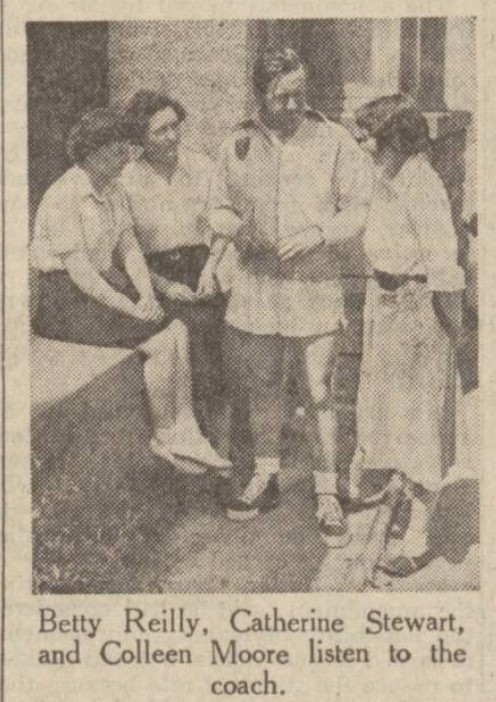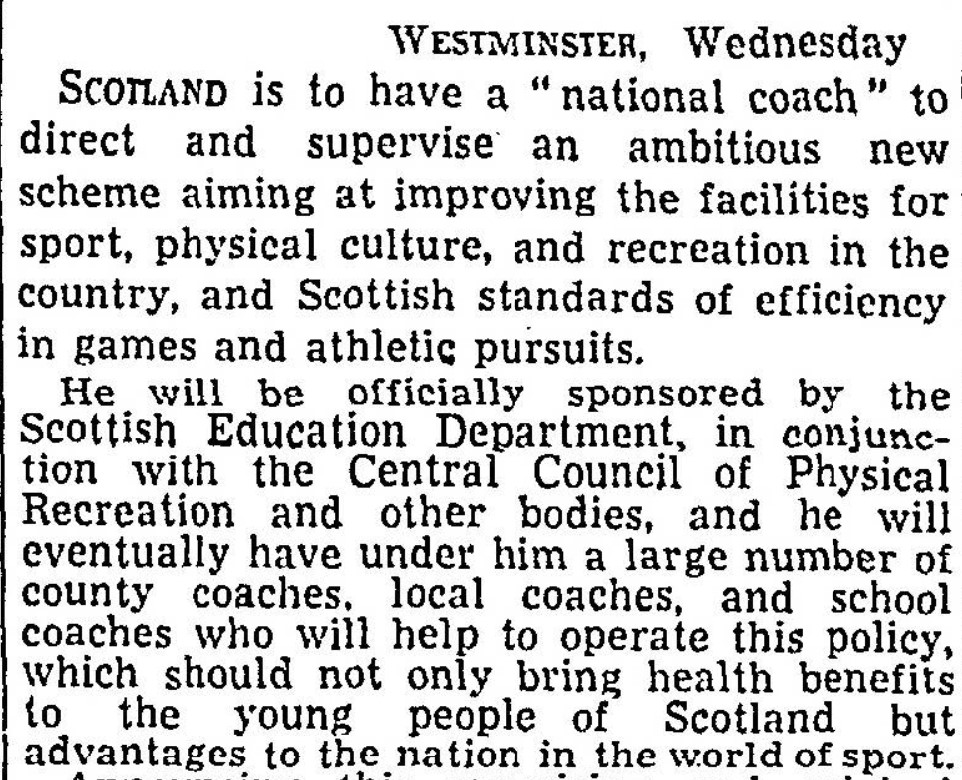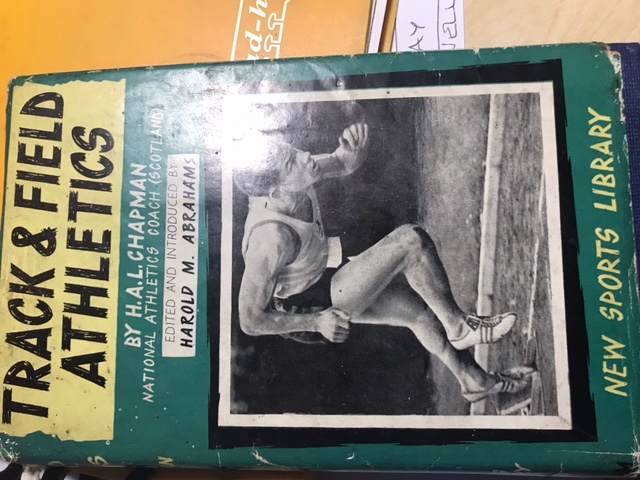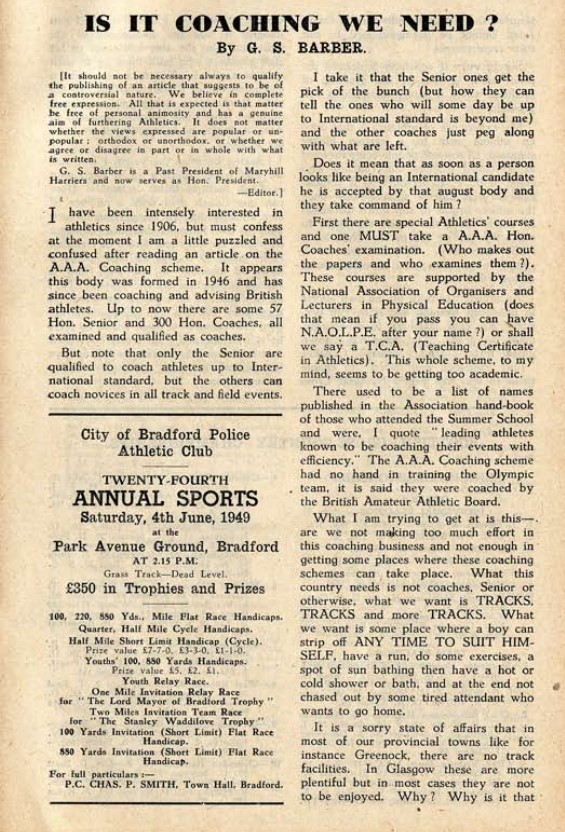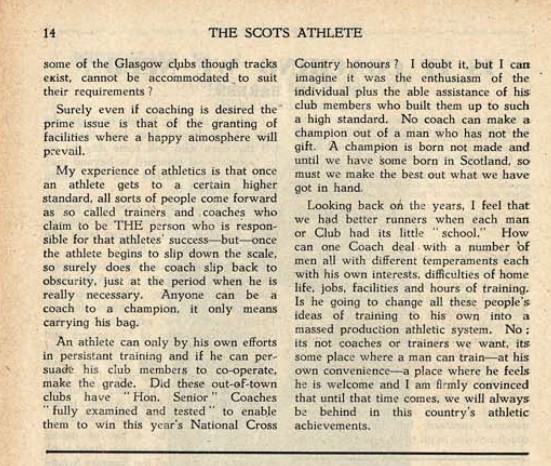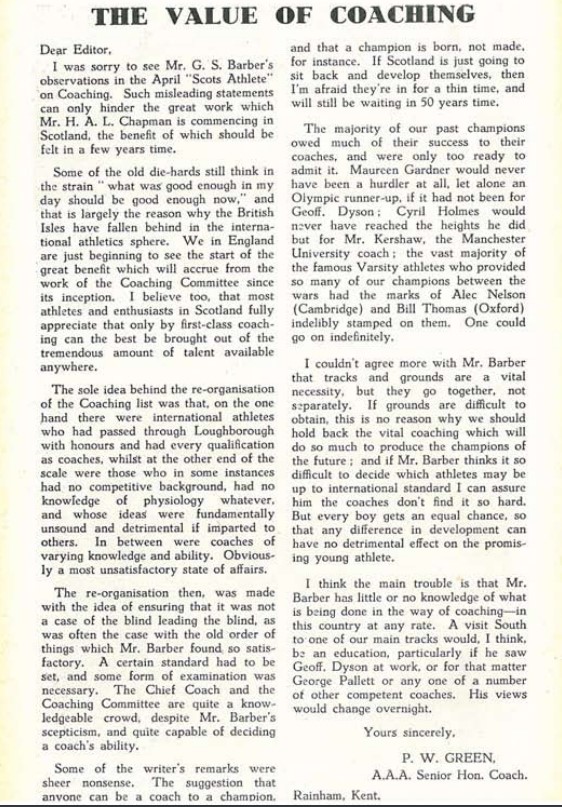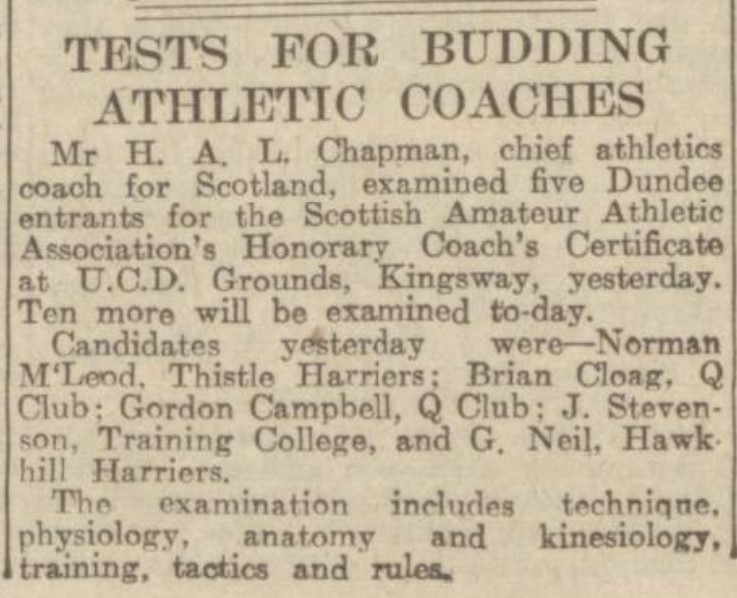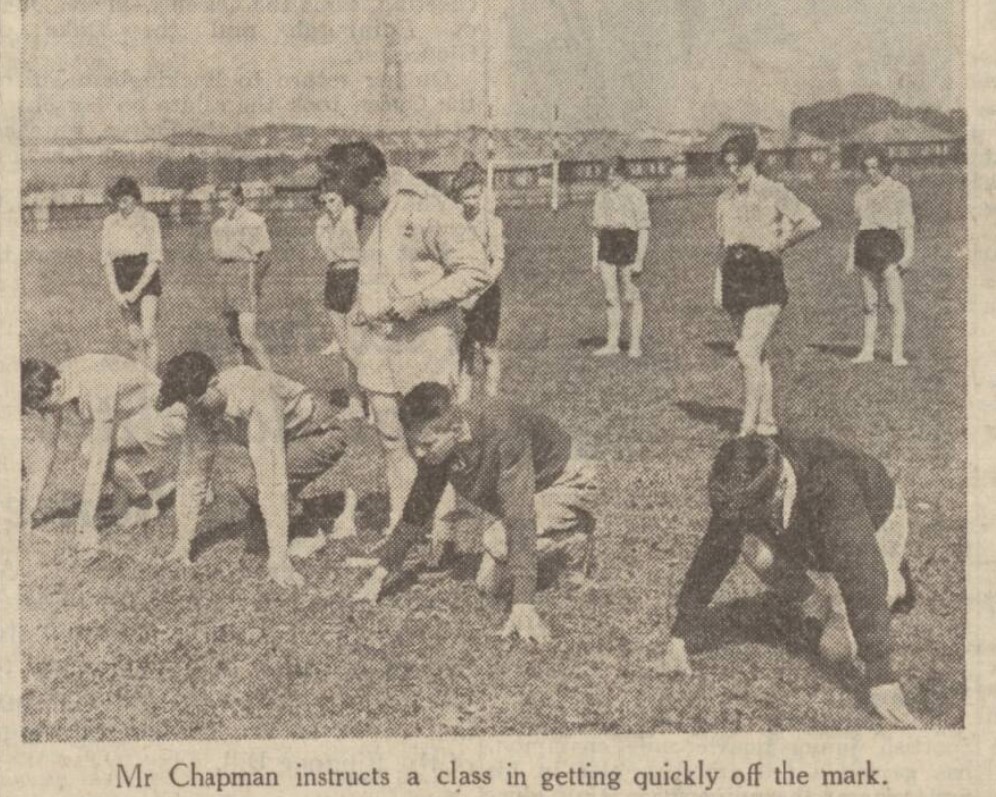The decision to appoint a National Coach for Scotland was taken early in 1948 and the details of the appointment and the activities to be undertaken were published in ‘The Scotsman’ on 25th March that year. The whole article can be found at this link. The opening paragraph was the one setting out the intentions however and it read:
Tony Chapman, pictured above with the girls of the Morgan Academy in Dundee in 1953, was appointed National Coach for Scotland in December 1948 One of the problems in the recent past – for the move towards a national coach and coaching set up was not new – had largely been to do with money. What had changed was that the project was not entirely funded by the SAAA. 80% of the funding was to come from the Scottish Education Department and the remaining 20% was to be found from the fees for his services to the clubs. This fee was a drawback – remember that we are talking about the aftermath of the War when newspapers were only 6 pages in total, when genuine austerity stalked the land. But in 1956 a new coaching levy of one guinea (£1:1:0 or £1:05 in new money) was introduced for all affiliated clubs. This was specifically for the National Coaching Committee. It was mandatory – every club when reminded that the annual subscription was due, was also reminded that there was a one guinea a year coaching levy. There were some rumblings about this and, when Chapman resigned in 1961, several clubs refused to pay the coaching levy when there was no national coach in post. We can come back to that later in return for the Coaching Levy, Realising that any national coach would need practical back up, the SAAA also arranged that any appointee would be a member of the Central Council for Physical Education. The appointment of HAL Chapman was announced on 15th December 1948 and he took up the role in April 1949. His job was not to tell coaches directly what to do but rather to administer a coaching system.
So who was Chapman? We knew that he came from Kent and thought that he was 23 years old (although he might have been 27), Sandy Sutherland described him thus:
Hugh Anthony Ledra Chapman was brought up in Plymouth (his father was a Rear-Admiral), attended Wellington School in Devon and saw service in the Royal Tank Regiment when his education was interrupted by World War II. Author (he wrote “Track and Field Athletics” which appeared in 1961 to the contemporary acclaim of ‘quite possibly the best pocket book yet written on athletics’), coach, demonstrator, educator, lecturer and no mean discus thrower, having represented the Army in Hanover in 1946 where he threw 140′ 3″, this chunky but suave Englishman was endowed with great personal charm which helped him to implement the ground-breaking National Coaching Scheme.
Well qualified, and given the fact that he was known in Scotland before his appointment, not the least of his qualities would be his ‘great personal charm’ .
Why the need for charm? Because not everyone was sold on the idea of coaching – the highly respected George Barber of Maryhill Harriers had this to say in the April 1949 issue of ‘The Scots Athlete’.
Chapman’s task would not be easy. There was a reply to the article the following month by Peter W Green (one of the founders of the Athletics Weekly) which read as follows:
Both sides were represented in the Scottish athletics community but there was a large majority on Peter Green’s side of the argument. One only has to look at the material published in ‘The Scots Athlete’ by such as James Logan, letters from Percy Cerutty, items quoted in Emmet Farrell’s ‘Running Commentary’ and later the series of articles under the title ‘Web Centre’ by Brian Mitchell to see that. Chapman’s task was probably tougher than it looked at first sight.
We referred above to the coaching levy and although clubs had the option of ‘contracting out’ of paying it, the first year saw 121 clubs signed up for the scheme and only 14 opted out. the scheme was supported by four groups:-
- The Department of Education for Scotland;
- National Committee for the Training of Athletic Coaches;
- the National Coaching Committee of the SAAA; and
- the Association of Athletic Coaches (Scotland).
What did the clubs get for their single guinea? They were guaranteed at least one visit from the national coach free of charge from 1st September 1956. 40 clubs were visited in 1957 and only 15 in 1958. Did this mean that the scheme was a failure? Not at all. The importance of coaching in athletics had been spoken of by many athletes at all levels, by informed journalists and by those with an interest in the sports despite the criticism of others involved. It was now, with the appointment of Chapman and the setting up of the Coaching scheme, granted the seal of official approval and significant public backing.
Tony worked in two dimensions: Coaching Coaches and, since it is impossible to keep coaches away from coaching, since there are always very good athletes wanting to move to the next level, he helped some of the nation’s best athletes. Coaching courses were set up that included both theoretical and practical aspects. One of the younger and more go-ahead clubs in the country at the time was the Q Club in Dundee. Set up in December 1949 with seven athletes, and organised in the main by Dr Bernard Devine, its first campaign was for a good track to be laid and the club organised, with much support to have it done from politicians at all levels and anyone with influence in the area. It then tackled the deficiency of quality coaching in the area just as Chapman was appointed. If we look at the extract from the ‘Dundee Courier’ of 3rd February, 1950, almost exactly one year after he took office, we see both aspects in evidence:
- theoretically the demands were higher than any previous organised coaching courses with subjects like physiology, Kinesiology and anatomy
- practically, there were training, technique, tactics and rules.
He returned in December, 1953 when the photographs taken at Morgan Academy were taken and show him taking an interest in the training of some of the pupils there. The photographs were taken on Friday 12th June when he took two sessions – one for the school pupils, from several local schools, in the afternoon dealing mainly with track athletics, and one for club athletes in the evening. He then took another session the following day.
It was a vast improvement on anything that had been available to clubs or to independent athletics coaches before and he was busy across the length and breadth of Scotland. Sandy Sutherland tells us that his coach, the very successful, highly respected throws coach Alec Dalrymple, who in turn inspired others like Sandy to take up the sport, had initially been enthused by one of Tony’s lectures. Sandy went on to say: “But in truth, Chapman, in his 12 years as Scotland’s national Athletics Coach, set alight a whole generation of Scottish coaches and physical education teachers, whose influence on the sport in the following decades is immeasurable.”
Sandy also spoke of tributes paid by two other eminent Scottish coaches.
One of Britain’s best ever National Athletics Coaches, Frank Dick, paid this tribute: Tony Chapman established our National Coaching Scheme as the first ever Scottish National Athletics Coach (and the second ever National Coach in any sport after the AAA appointed Geoff Dyson). A giant of a man, from Scottish Schools Easter Courses to teacher and coach development, to personal coaching excellence, he changed how Scotland thought about athletics and how it performed. My personal debt to him was in his coaching when an athlete, and his mentorship and guidance when following John Anderson as national coach.
Sandy Robertson one of Scotland’s longest serving and most experienced senior coaches, who interrupted his teaching career for a time to become National Coach for Malawi, maintains that he would never have achieved that post but for Chapman. “He had tremendous proficiency as a lecturer, his explanations were marvellous and I’ve never seen clearer course notes – I spent a week at Inverclyde where he covered every event and it was a complete and utter knock-out. I remember him bringing a 3’6″ hurdle into the small lecture room and then going over it – I’d never seen it so close up. He introduced me to PFI testing and the Harvard Step Test and brought in all of that interesting science.”
Clearly an inspirational coach, whose ‘charm’ had been used to good effect, but he had been a hard working, talented, very active and clear sighted coach. John Keddie, in his Centenary History of Scottish Athletics, reported on his effect on the sport in Scotland:
“At the end of 1961 the Association suffered a loss in the resignation of the National Coach, Tony Chapman. In his 12 years in that capacity,, Chapman had done much to foster athletics in Scotland and to improve standards of coaching, training and techniques. A highly respected coach, he wrote a book entitled “Track and Field Athletics” (1961) which the “1968 Guide to British Track and Field Literature, 1275 to 1968”, produced by Tom McNab and Peter Lovesey, described as ‘possibly the best pocket book yet written on athletics’. Praise indeed!
